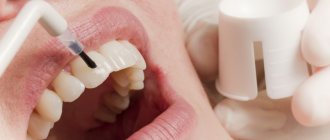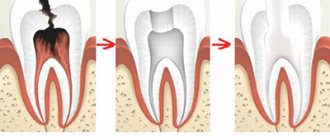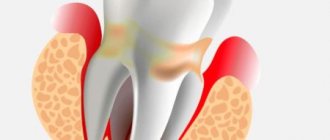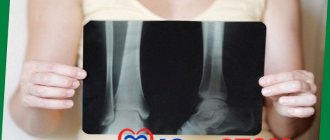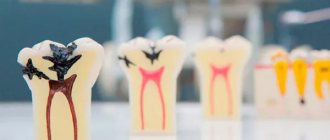In accordance with current world requirements, doctors make every effort to preserve the tooth and prevent its complete removal. One of the most modern solutions is hemisection. This operation became possible thanks to the development of medical technology.
Hemisection, or tooth amputation, is a complex operation during which one of the roots of a multi-rooted dental element and the adjacent part of the crown are amputated. The technique is chosen if only one root is affected and the rest are healthy.
The operation does not guarantee absolute success due to the risk of losing the remaining part. The remaining part of the root may not withstand the full load and disrupt the stability of the tooth. In any case, doctors recommend taking advantage of the opportunity to preserve the element.
The essence of the method
If a tooth has several roots, on one of which a granuloma or cyst has formed, complete removal is not necessary. Hemisection involves amputation of the affected part, leaving healthy tissue unaffected. After the operation, the natural support of the tooth is preserved, so restoration and restoration of chewing function is possible. Your own tooth is better than any modern implant. If it is possible to save it, you should do so.
What is tooth hemisection
Hemisection is a modern surgical therapy technique that can be used for teeth with two or more roots. The operation consists of removing tooth tissue affected by the inflammatory process. Both the root and the crown can be excised. Hemisection allows you to preserve the functionality and, in some cases, the integrity of the tooth. If a few years ago, if infectious formations appeared near the root of the tooth, the unit would have to be removed, today the tooth can be saved thanks to hemisection. However, it is worth considering that surgical intervention can only be performed if at least one healthy tooth root is preserved.
Indications
The operation is performed only on teeth that have two or more roots. After removing the affected area, a root should remain that firmly holds the tooth. Indications for hemisection are:
- inability to treat the root;
- cyst;
- granuloma;
- perforation;
- root caries;
- the impossibility of cleaning the canals due to their irregular shape or small diameter;
- chronic periodontitis;
- mechanical damage.
Hemisection is also performed in childhood. Dentists are often faced with the impossibility of endodontic treatment due to tortuous canals. But preserving a child’s tooth is important, since prosthetics using implants is only possible in adults, and many children refuse to wear a removable denture.
Cost of services
Consultation with an implant surgeon 0 rub.
Hemisection 2,500 rub.
Expert of the article you are reading:
Lyubomskaya Olesya Alekseevna
Dental surgeon-implantologist, dental therapist, dentist - orthopedist (K.M.N.) (Candidate of Medical Sciences).
You may also be interested in:
Wisdom tooth removal Tooth extraction Removal of the dental nerve Complex tooth extraction Resection of the apex of the tooth root Removal of an impacted tooth Removal of the tooth root Removal of a dystopic tooth
Show more
Contraindications
The operation is not performed on teeth that have one root, or when the other roots are also affected. In these situations, it is impossible to save the tooth because it has no support.
Fused roots are another obstacle to tooth-preserving surgery. In this case, it is impossible to separate the affected tissues from healthy ones.
The operation is not performed in elderly patients or in patients with severe somatic diseases: diabetes mellitus, oncology, kidney damage, or cardiovascular disease. If there are doubts that a person will safely undergo hemisection for health reasons, it is better to remove the tooth.
Features of postoperative recovery
How rehabilitation will go after hemisection of a tooth largely depends on the patient’s behavior. To prevent the development of complications, the patient should adhere to the recommendations for oral care:
- In the first 2-3 days, do antiseptic baths. After this period has expired, regularly rinse your mouth with an antiseptic mouthwash.
- In the first two days after surgery, avoid brushing the teeth located around the operated area. This is necessary in order not to damage the seams. On the third day, you can try to brush all your teeth with a soft toothbrush using gentle movements.
- After every meal you should rinse your mouth.
- In the first days after the procedure, you are allowed to take painkillers, as pain may normally be present.
- Take antibiotics as prescribed by your doctor. You should not stop taking these medications ahead of schedule.
- Use vitamin complexes, immunostimulants and other auxiliary medications as prescribed by your doctor.
- In the first days after hemisection, avoid physical activity, as well as any thermal procedures (baths, saunas, etc.).
- Until the gum mucosa is completely healed, it is better not to eat food that will irritate soft tissues (too salty, peppery, hot, hard).
- Avoid drinking alcohol and tobacco until the wound is completely healed.
Advantages and disadvantages
The technique allows us to ensure the safety of even hopeless teeth. The restoration will have to be done with a crown, but it will have natural support. It is safer and more reliable than the introduction of an artificial implant.
The operation rarely leads to complications. With the correct technique for performing the procedure and proper preparation, the dentist can achieve results.
The remaining part of the root cannot restore the tooth to its former strength. For this reason, it is recommended to limit chewing loads and not use teeth after hemisection as support for bridges. There is no guarantee that the root will maintain its integrity for several years.
Postoperative complications include: bleeding, secondary infection, suture dehiscence. This often occurs when the rules of asepsis and antisepsis are violated during manipulation and the patient does not comply with the doctor’s recommendations during the rehabilitation period.
Recommendations for rehabilitation
If the patient is aware of an allergy to medications, then to eliminate the risks of complications and a possible negative reaction of the body, the surgeon should be informed. Modern pharmacology allows you to select the most safe anesthetic for the patient’s health.
To speed up the recovery process, you should refrain from eating for two to three hours after surgery. In addition, it is necessary to exclude hard, spicy, too cold or hot foods from the diet. Physical activity and heavy lifting are not recommended for two weeks.
Operation technique
Hemisection refers to volumetric surgical interventions. The procedure lasts 1.5-2 hours. For pain relief, local or general anesthesia is used. The choice depends on the individual characteristics of the patient and the technique used.
Hemisection can be performed by two methods: access from above or by peeling off a skin flap.
When choosing the first method, the crown is sawed to the point where the roots emerge. In this way, the affected root, together with part of the crown, is separated from healthy tissue. After separation, the damaged area is removed.
The second method is carried out by cutting the gums. In the area of projection of the affected area, the flap is peeled off, part of the root is sawed off and removed. Stitches are applied.
After removing one of the roots, a void remains in the jaw. If left, it will fill with granulation tissue, which is considered an unfavorable outcome. To prevent this, artificial bone is poured into the cavity and covered with a membrane. The material is biocompatible and is rarely rejected.
Prosthetics are not performed immediately after surgery. We need to wait for complete healing. This takes at least a month. If the recovery period passes without complications, a crown can be installed. Sometimes, to increase strength, stump inlays are used to evenly distribute the load on the root and protect it from fracture.
Application of the technique in dentistry
The surgical technique is used by specialists in the following cases:
- if surgical treatment is necessary for adolescents. Tooth extraction can negatively affect the formation of the bite;
- hemisection is used to eliminate a tumor located in close proximity to the root. The use of the technique allows you to excise only the pathological area without affecting healthy tissue;
- removal of only one root will solve the problem of treating its fracture and preserve the healthy part of the organ;
- root amputation using hemisection allows you to eliminate long-term infectious inflammation of surrounding tissues, which cannot be treated by other methods;
- surgery may be required to eliminate the purulent focus. If an accumulation of inflammatory fluid has formed in one of the roots, it is not necessary to remove the entire organ to remove it; it is enough to perform a hemisection;
- in some cases, it is impossible to cure the carious process by cleaning and filling all root canals due to their complex anatomical structure. This circumstance especially concerns narrow root canals. In this case, surgical intervention will help eliminate the pathological process - excision of the root and part of the crown;
- hemisection of a tooth is the most gentle way out of a situation when it is necessary to remove a dental instrument stuck in the root canal.
Possible complications
Bleeding may occur during the operation or after the intervention. This is relevant for people with poor blood clotting, taking antiplatelet drugs, and smokers. For this reason, intervention is not recommended for patients with bleeding disorders. If you are taking some medications regularly, you may need to temporarily stop them. You will have to give up cigarettes before hemisection and in the postoperative period.
The tooth, part of which is removed, usually shows signs of inflammation and serves as a source of infection. Insufficiently thorough sanitation of the lesion during surgery can lead to the development of a secondary inflammatory process. The reason may also be improper treatment of the dentist’s hands and unsterile instruments. The infection can be caused by the patient himself after treatment. Failure to maintain oral hygiene and ignoring doctor's recommendations often lead to serious purulent complications.
Even after a successful operation, there is no guarantee that the remaining root will cope with the increased load. Sometimes the tooth has to be removed several months after hemisection.
Preparing for amputation
Resection of a part of the tooth is carried out after preliminary preparation, including collection of a medical history, instrumental diagnostics, consultations with an orthopedist and other doctors of related specialties. Surgical intervention is preceded by complete sanitation of the oral cavity and conservative treatment, during which the dentist cleans and fills healthy root canals. At the end of the manipulations, a control x-ray is taken.
The appointment includes consultation and drawing up a treatment plan with cost determination
sign up for a free consultation
Not ready for an in-person consultation with a doctor? Ask your question by phone
